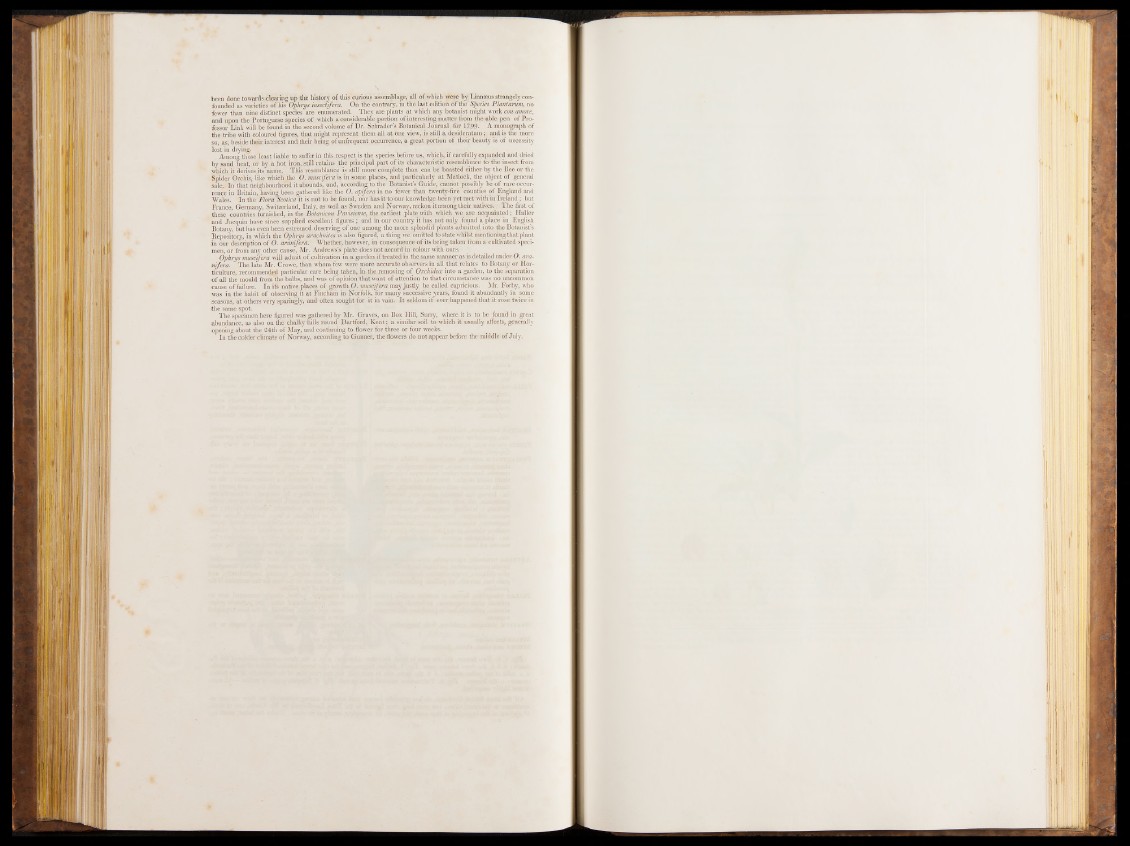
been done towards clearing up the history of this curious assemblage, all of which were by Linnæus strangely confounded
as varieties of his Ophrys insectifera. On the contrary, in the last edition of \he'Species Plantarum, no
fewer than nine distinct species are enumerated. They are plants at which any botanist might work con amore,
and upon the Portuguese species of which a considerable portion of interesting matter from the able pen of Professor
Link will be found in the second volume of D r. Schrader’s Botanical Journal for 1799- A monograph of
the tribe with coloured figures, that might represent them all at one view, is still a desideratum ; and is the more
so, as, beside their interest and their being of unfrequent occurrence, a great portion of their beauty is of necessity
lost in drying. . . .
Among those least liable to suffer in this respect is the species before us, which, if carefully expanded and dried
by sand heat, or by a hot iron, still retains the principal part of its characteristic resemblance to the insect from
which it derives its name. This resemblance is still more complete than can be boasted either by the Bee or the
Spider Orchis, like which the 0 . muscifera'is in some places, and particularly a t Matlock, the object of general
sale. In that neighbourhood it abounds, and, according to the Botanist’s Guide, cannot possibly be of rare occurrence
in Britain, having been gathered like the O. apifera in no fewer than twenty-five counties of England and
Wales. In the Flora Scotica it is not to be found, nor has it to our knowledge been yet met with in Ireland ; but
France, Germany, Switzerland, Italy, as well as Sweden and Norway, reckon it among their natives. The first of
these countries furnished, in the Botanicon Parisiense, the earliest plate with which we are acquainted ; Haller
and Jacquin have since supplied excellent figures ; and in our country it has not only found a place in English
Botany, but has even been esteemed deserving of one among the more splendid plants admitted, into the Botanist’s
Repository, in which the Ophrys arachnites is also figured, a thing we omitted to state whilst mentioning that plant
in our description of O. aranifera. Whether, however, in consequence of its being taken from a cultivated specimen,
or from any other cause, Mr. Andrews's plate does not accord in colour with ours.
Ophrys muscifera will admit of cultivation in a garden if treated in the same manner as is detailed under 0 . aranifera.
The late Mr. Crowe, than whom few were more accurate observers in all that relates to Botany or Horticulture,
recommended particular care being taken, in the removing of Orchidea into a garden, to the separation
of all the mould from the bulbs, and was of opinion that want of attention to that circumstance was no uncommon
cause of failure. In its native places of growth O. muscifera may justly be called capricious. Mr. Forby, who
was in the habit of observing it at Fincham in Norfolk, for many successive years, found it abundantly in some
seasons, a t others very sparingly, and often sought for it in vain. I t seldom if ever happened that it rose twice in
the same spot.
The specimen here figured was gathered by Mr. Gravés, , on Box Hill, Surry, where it is to be found in great
abundance, as also on the chalky hills round Dartford, Kent; a similar soil to which it usually affects, generally
opening about the 24th of May, and continuing to flower for three or four weeks.
In the colder climate of Norway, according to Gunner, the flowers do not appear before the middle of July.